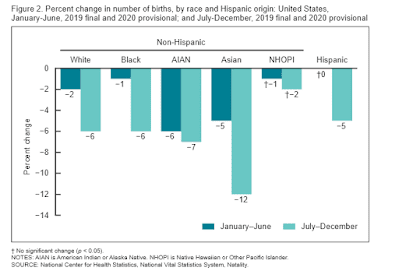After three decades of sharp decline,
American Indians now have the lowest fertility rate of all ethnic groups in the
U.S. The trend is real and is not due to sub-fertile Whites self-identifying as
American Indians.
The
pandemic has reduced the American birth rate. According to data from 2020 and
early 2021, almost all ethnic groups have taken a hit, but the magnitude has
been greater for some than for others.
Asian Americans took the biggest hit. At first thought, this makes sense. Asians, especially East Asians (who make up a majority of Asian Americans) tend to take infectious diseases more seriously. They are generally more willing to wear masks, practice social distancing, and wash their hands, and it seems logical that they would also be more willing to postpone childbearing.
But
that's not the whole story. The pandemic has accelerated an ongoing fertility
decline among East Asians at home and abroad. With the exception of North Korea,
East Asia was already a zone of ultra-low fertility—about one child per woman.
When the pandemic is over, I predict that East Asian fertility will not return
to pre-pandemic levels. The decline will continue. The pandemic has merely
acted as a social accelerant (Frost 2020).
This view is strengthened if we return to the above graph and look at the group that took the second-biggest hit: American Indians and Alaskan Natives. Their fertility rate has likewise been declining. It was still high in the 1980s, but sometime around 1990 it began to plummet, falling below the fertility rate of any other ethnic group in the U.S. by the early 2000s.
What's
going on? Is the decline real? Or is it a statistical fluke? Perhaps
sub-fertile Whites are self-identifying as American Indians in growing numbers.
This hypothesis was tested by Cannon and Percheski (2017):
Concurrent with this decline in estimated TFRs, the self-identified AI/AN population enumerated in the decennial US Census increased in size, largely because of changes in the racial categories and in the wording of racial identity items on the census forms.
The increase in the census counts of the American Indian population means that there are several possible explanations for the decline in American Indian fertility rates published by Vital Statistics. First, the decline could be a mechanical artifact of differential changes in racial identification between the two data systems Vital Statistics used to calculate fertility rates. Second, the decline could be driven by compositional changes in who identifies as American Indian. Third, there may be real changes infertility behavior that are unrelated to changes in who identifies as American Indian.
To
control for these differences in definition and self-identification, Cannon and
Percheski (2017) used a single data system (the American Community Survey) for
the period 1980 to 2010. They also examined the fertility decline on the basis of
three definitions of American Indian/Alaskan native: 1) women who identify as
AI/AN only, 2) any woman who identifies as AI/AN, whether identifying one or
more races, and 3) women who list a specific tribe or American Indian for the
ancestry question. The second definition seems to be the one most vulnerable to
"ethnic reassignment."
Cannon
and Percheski (2017) found that all three definitions showed a fertility
decline, particularly the first one. The decline was steepest among younger
women. However, there was no indication that lower fertility at younger ages
was being offset by higher fertility at older ages. The authors concluded:
"This finding of declining TFRs estimated within a single data system is
evidence against the explanation that fertility declines are merely artifacts
of data collection changes or incongruences."
So
what is the explanation? The main cause seems to be the declining marriage
rate: "fertility rates among married and unmarried women have remained
fairly stable, while the share of women ever married has declined across birth
cohorts. Thus declines in fertility rates seem to be linked with changes in
marriage for this population."
In
this respect, American Indians are more vulnerable than most other ethnic
groups in the U.S. Their women seem to prefer having children when a man is in
the home. As the authors note, "other population subgroups in the United
States who have experienced substantial declines in marriage have not
experienced such drastic declines in fertility levels" (Cannon and
Percheski 2017, pp. 8-9).
Anthropologists
have long noted that the Indigenous peoples of the Americas still retain many
"Arctic" adaptations in their anatomy. Could the same be true for
their behavioral predispositions? Some 12,000 years ago, their ancestors lived
in northeast Asia and Beringia. In that environment, women had almost no food
autonomy and could not raise children on their own. Perhaps their female
descendants are still making a half-conscious link between having a baby and
having a male provider.
References
Cannon,
S., and C. Percheski. (2017). Fertility change in the American Indian and Alaska
Native population, 1980-2010. Demographic
Research 37: 1-12.
http://www.jstor.org/stable/26332188
Frost,
P. (2020). An Accelerant of Social Change? The Spanish Flu of 1918-19.
International Political Anthropology
Journal 13(2): 123-133.
https://doi.org/10.5281/zenodo.4295574
Hamilton,
B.E., M.J.K. Osterman, and J.A. Martin. (2021). Declines in births by month: United States, 2020. NVSS Vital Statistics
Rapid Release. Report no. 14, June
https://www.cdc.gov/nchs/data/vsrr/vsrr014-508.pdf


